Rogers Spring
Lk. Mead Natl. Rec. Area
Overview:
Just over an hours drive from the Las Vegas area, Rogers Spring a desert oasis, is one of the most accessible warm springs in southern Nevada.
Located along Northshore Road in Lk. Mead Natl. Rec. Area, this desert spring resembles a small pond, measuring approx. 75 feet in diameter and about 3 feet deep with a "soft" bottom and year round water temperatures which average around 85°F.
Of interest, water discharge from the "Rogers Spring Fault System" totals approx. 1,000gpm (gallons per minute) with approx. 400gpm flowing into Rogers Spring itself.
Rogers Spring and other springs in the “North Shore Complex” comprise one of the terminal discharge areas for the regional "carbonate-rock aquifer" system of eastern Nevada and western Utah.
The source of the water to Rogers Spring and other regional carbonate-rock aquifer springs is not fully understood.
However, the predominant theory suggests that much of the "recharge water" that enters the carbonate-rock aquifer occurs in the high mountain ranges around Ely, Nevada which is located approx. 250 miles north of Lake Mead.
As the ground water flows south thru the carbonate rock, it encounters several faults along the way, including the Rogers Spring Fault.
Over time, the Rogers Spring Fault caused older carbonate rocks (primarily limestone and dolomite) to be displaced against younger "evaporite deposits" which typically form in environments where evaporation exceeds inflow.
At Rogers Spring, the lower porosity of these "evaporite deposits" along with high sub-surface water pressure, forces the ground water in the carbonate rocks to flow upward along the fault and emerge at the surface.
According to the National Park Service (and other sources) Rogers Spring has a colorful history, some of which is presented here.
(1) Historically the area now known as Rogers Spring was "utilized" by native peoples who lived in and traveled thru the area before farming and mining took hold.
(2) In 1903 a project was initiated to build a canal to divert water from Rogers Spring (and nearby Blue Point Spring) to farmland located several miles south of the now famous ghost-town of St. Thomas, Nevada.
Utilizing a horse team, scraper, home-make "ditcher" and shovels the project eventually constructed a channel to the springs.
Upon completion, the channel was tested only to discover that the intended irrigation water (after traveling a short distance) soaked into the desert ground.
Undaunted, the channel was lined with clay and when that failed was once again lined with cement.
Eventually, water was successfully transported to the intended farmland, but the project ultimately failed due to economic reasons.
(3) A water-fowl refuge construction project, initiated from 1938 to 1943, that was never completed.
(4) A tropical fish hatchery was operated at the nearby Blue Point Spring during the mid 1950s which may have introduced non-native tropical fish into Rogers Spring.
(5) Today, the National Park Service recognizes the importance of Rogers Springs from both an ecological and recreational standpoint, proactively protecting all known water features from the potential adverse effects of large-scale ground water pumping in the regional carbonate-rock aquifer.
Rogers Spring is a popular destination for visitors traveling the Northshore Road.
Around the spring, lush greenery provides a "tropical feel" which is in stark contrast to the unforgiving Mojave Desert which surrounds it.
Watch for wildlife (especially the tropical fish swimming its waters) while having a picnic, taking in the sights or wading in Rogers Spring's warm waters (see NAEGLERIA FOWLERI warning below).
With large looming mountains on the horizon and a glimpse of Lk. Mead in the distance, this "beautiful" warm spring has a lot to offer, being well worth a visit.
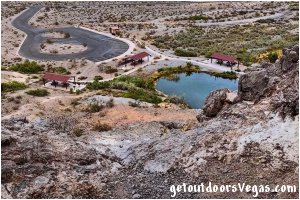

...Rogers Spring
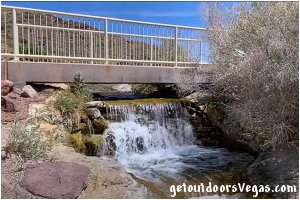
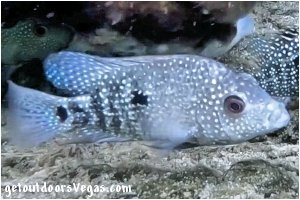
Information / Tips:
This adventure would make a great stopover while enjoying the Lake Mead National Recreation Area.
Bring plenty of water / snacks, hat, sunscreen, sunglasses and comfortable shoes.
Make sure you have a full tank of gas and a fully pressurized spare tire.
DON'T forget your camera.
..........
Rogers Spring (site amenities):
• ample parking with over-sized and ADA stalls
• restroom facility, trash receptacles
• concrete walkways (ADA accessible)
• covered picnic tables, barbecue grills
• information kiosk
• dogs allowed (on leash)
• day use only: no camping allowed
• drones: NOT allowed within
Lk. Mead Natl. Rec. Area
• No Drinking Water Available
..........
Rec. Area Hours 24hrs/day, 365days/year
2023 Entry Fee (valid 7 days): $25 vehicle & occ.
Free Entry Days (dates vary by year):
* M. L. King Jr. Day - mid January
* 1st day of Natl. Park Week - mid April
* Great Amer. Outdoors Act - EARLY AUGUST
* Natl. Park Service Birthday - LATE AUGUST
* Natl. Public Lands Day - LATE SEPTEMBER
* Veterans Day - mid November
..........
nearby: Redstone
nearby: St. Thomas
nearby: Valley of Fire
Warning:
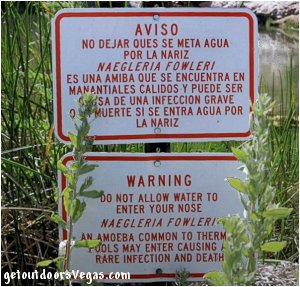
NAEGLERIA FOWLERI is commonly found in bodies of warm fresh water.
This amoeba infects people by entering the body thru the nose and traveling to the brain.
It does not infect people if swallowed and is not spread person to person.
The infection rate is extremely rare and is almost always fatal.
Recreational water users should always assume there is a risk when entering warm fresh water and take precaution.
Recommended precautions from the Centers of Disease Control and Prevention include:
• avoid jumping or diving into bodies of
warm fresh water, especially during
the summer
• hold your nose shut, use nose clips
or keep your head above water when
in bodies of warm fresh water
• avoid putting your head underwater in
hot springs and other untreated
geothermal waters
• avoid digging in, or stirring up the
sediment in shallow warm fresh water
..........
This adventure involves travel to a relatively remote area, please refer to the section on desert travel for safety information.
• Watch your kids (and dogs) around water
(see: Naegleria Fowleri warning above)
• Be mindful of lightning / flash floods
• Watch for snakes
• AVOID THE AREA DURING EXTREME HEAT
• You are responsible for your own safety
Directions:
From the intersection of NV-564 (E. Lk. Mead Pkwy.) and NV-167 (Northshore Rd.) within Lk. Mead National Recreation Area head North on Northshore Rd. traveling just over 40 miles to the signed turnoff (WP1) for Rogers Spring.
Turn Left (Westerly) and proceed 0.1 miles+- to the Rogers Spring parking area.
Return by reversing route.
Approx. 64 miles from central Vegas Strip via I-15 South, I-215 East, NV-564 East (E. Lk. Mead Pkwy.) and NV-167 (Northshore Rd.) to the Rogers Spring parking area.
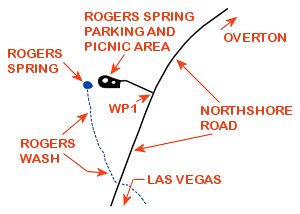
WP1: N36.37745 W114.44123
northshore rd. @ rogers spring turnoff
Note:
See desert travel for GPS Waypoint info
All distances and waypoints are approximate
